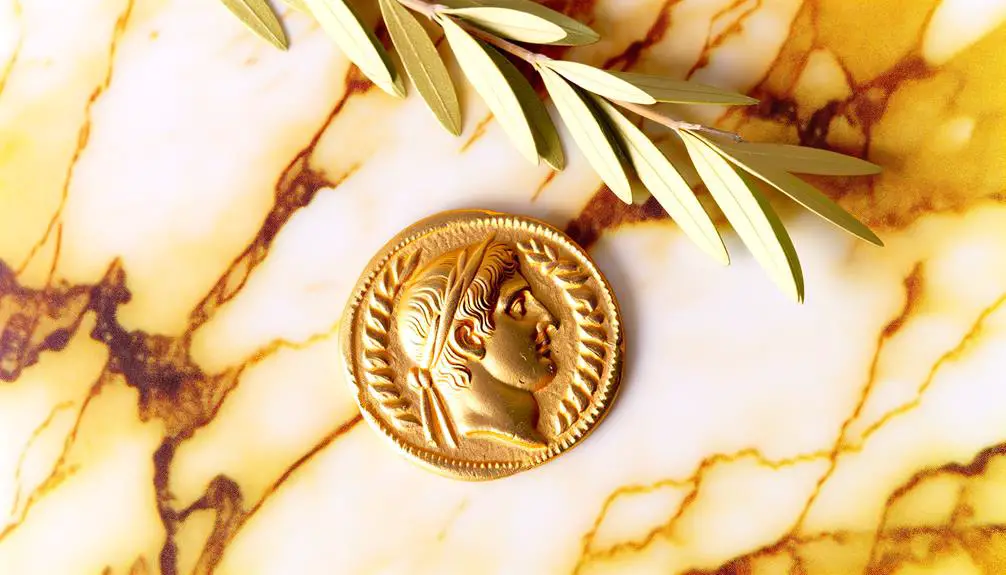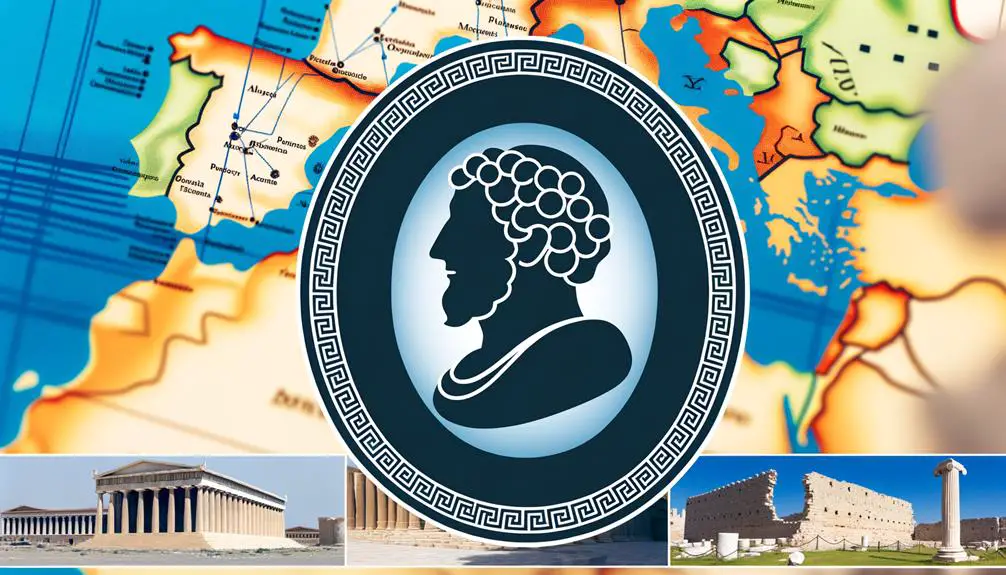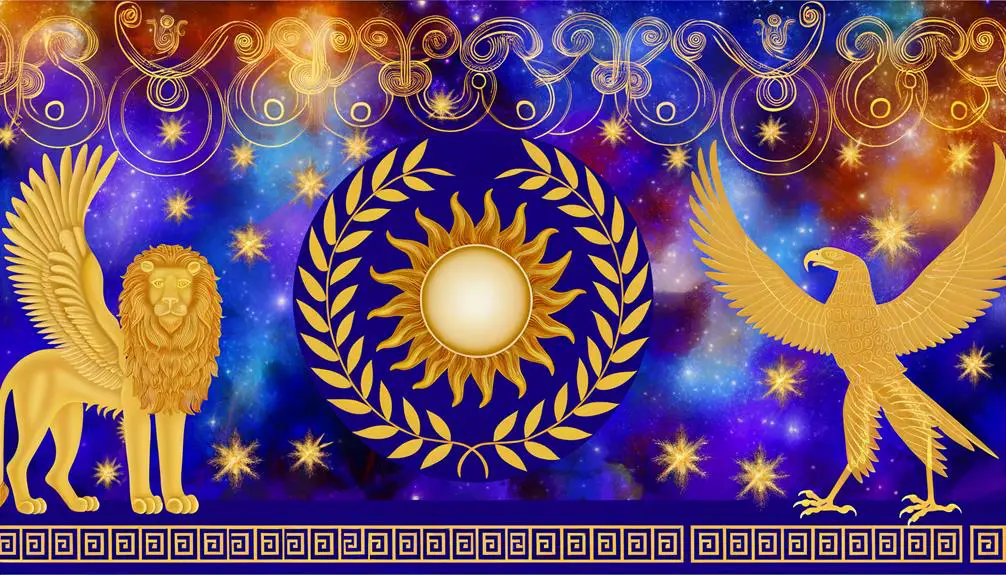Identifying Symbols of Alexander the Great
Alexander the Great is symbolized by various emblems that reflect his strategic brilliance and profound influence. The Gordian Knot represents his innovative problem-solving approach, while the Phalanx Formation illustrates his effective military tactics.
The Macedonian Sun signifies his royal authority and national pride. His helmet and the royal diadem symbolize martial prowess and monarchical legitimacy, respectively.
Alexander's legacy is also seen in the numerous cities named Alexandria, showcasing Hellenistic culture's spread. Each of these symbols offers a glimpse into the multifaceted aspects of his leadership and enduring impact, providing a richer understanding of his historical significance.

Key Takeaways
- The Gordian Knot symbolizes Alexander's strategic ingenuity and problem-solving approach.
- The Macedonian Sun represents Macedonian identity and royal authority.
- Alexander's Helmet signifies military genius and advanced martial craftsmanship.
- The Royal Diadem communicates monarchical supremacy and divine right to rule.
- The Phalanx Formation illustrates disciplined and cohesive military tactics.
The Gordian Knot

The story of the Gordian Knot serves as a potent symbol of Alexander the Great's approach to problem-solving and his decisive leadership. According to legend, an intricate knot tied by Gordius could only be untangled by the future ruler of Asia.
Confronted with this challenge, Alexander did not attempt to unravel it conventionally; instead, he sliced through it with his sword. This act illustrates his preference for direct, bold solutions over protracted deliberations. Historically, this anecdote underscores Alexander's strategic ingenuity and his ability to think beyond traditional constraints.
His decisive action in cutting the Gordian Knot exemplifies his leadership style: audacious, innovative, and unafraid of radical measures to achieve his objectives, thereby cementing his status as a transformative historical figure.
The Phalanx Formation
Alexander the Great's strategic ingenuity extended beyond singular acts of boldness, as evidenced by his masterful use of the phalanx formation to achieve military dominance. This formation, characterized by tightly-knit infantry units armed with long spears (sarissas), provided both offensive and defensive advantages. It allowed for a highly disciplined and cohesive force that could withstand and penetrate enemy lines. The phalanx's effectiveness can be analyzed through its key features:
| Feature | Description |
|---|---|
| Weapon | Sarissa, a long spear approximately 18-22 feet |
| Formation | Rectangular, densely packed soldiers |
| Mobility | Limited but highly effective in open fields |
| Defense | Interlocking shields creating a formidable wall |
| Training | Rigorous, ensuring synchronization and unity |
The Macedonian Sun

Emerging as a potent emblem of Macedonian identity and royal authority, the Macedonian Sun, also known as the Vergina Sun, symbolizes the power and legacy of Alexander the Great's empire.
This emblem, characterized by a stylized sunburst with sixteen rays, was discovered on a golden larnax in the royal tombs of Vergina, believed to belong to Alexander's father, King Philip II.
The Macedonian Sun represents:
- Royal lineage: Signifying the divine right of the Argead dynasty.
- Cultural identity: Reinforcing a shared heritage among Macedonians.
- Military prowess: Embodying the strategic and expansive nature of Macedonian conquests.
- Historical continuity: Linking ancient Macedonian glory to modern national symbolism.
Its historical and cultural significance remains a subject of scholarly debate and national pride.
Alexander's Helmet
Beyond the emblematic Macedonian Sun, another potent symbol of Alexander the Great's legacy is his helmet, an artifact that epitomizes his military genius and the martial culture of his era.
This helmet, often depicted in ancient sculptures and coins, was designed not merely for protection but also as a statement of power and authority. Crafted with intricate designs, it likely incorporated elements such as a plume and cheek guards, reflecting both practical and aesthetic considerations.
Historical accounts suggest that Alexander's helmet was made of iron, an advanced material at the time, which underscores his commitment to utilizing cutting-edge technology. This helmet serves as a tangible representation of Alexander's strategic prowess and the sophisticated military infrastructure he commanded.
The Royal Diadem

The Royal Diadem, a symbol of monarchical authority, encapsulates the convergence of Alexander the Great's political acumen and his vision of a unified empire. This headband, often adorned with precious gems, signified not only royal status but also the divine right to rule. Its adoption by Alexander served multiple purposes:
- Legitimacy: Reinforced his claim to the throne and continuity with previous rulers.
- Unity: Symbolized the integration of diverse cultures within his expanding empire.
- Divinity: Linked him to the gods, bolstering his image as a semi-divine leader.
- Authority: Asserted his dominance and control over conquered territories.
Through the Royal Diadem, Alexander effectively communicated his supremacy and the ideological framework underpinning his reign.
The Bucephalus Legend
The Bucephalus legend recounts Alexander the Great's extraordinary taming of an unruly horse. It has been widely interpreted as a symbolic representation of Alexander's exceptional leadership qualities and strategic prowess.
Historical accounts emphasize Bucephalus as proof of Alexander's early demonstration of control and insight. They also highlight the horse's indispensable role in numerous military campaigns, reinforcing Alexander's image as a formidable and astute commander.
These narratives underscore the profound bond between Alexander and Bucephalus, cementing the horse as a potent symbol of his enduring legacy.
Taming the Wild Horse
How did a young Alexander demonstrate his extraordinary leadership abilities and strategic acumen through the legendary taming of Bucephalus? This pivotal event offers critical insights into his nascent leadership qualities.
To start, Alexander observed that Bucephalus was frightened by his own shadow, showcasing his acute observational skills.
Following that, he approached the horse calmly, establishing trust and displaying emotional intelligence.
Lastly, he turned Bucephalus towards the sun, mitigating the shadow and demonstrating strategic thinking.
To conclude, he mounted and tamed the horse, symbolizing his fearless resolve and innate leadership.
Key elements emphasized include:
- Observation: Recognized the horse's fear of shadows.
- Calm Approach: Established trust through controlled demeanor.
- Strategic Action: Redirected the horse towards the sun.
- Fearlessness: Successfully tamed and rode Bucephalus.
Battle Companion Stories
Alexander's profound bond with Bucephalus extended beyond the initial taming, evolving into a legendary partnership that greatly impacted his military campaigns.
Historical accounts suggest that Bucephalus was more than just a steed; he was a symbol of Alexander's strategic prowess and resilience.
Their collaboration in battles, such as the decisive Battle of Gaugamela, where Bucephalus' unyielding stamina enabled Alexander to outmaneuver Darius III, exemplifies their mutual trust and coordination.
This synergy between horse and rider not only bolstered troop morale but also served as a psychological weapon against adversaries.
Additionally, Bucephalus' presence in numerous victorious encounters reinforced Alexander's image as an invincible leader, embedding the horse deeply into the lore of his expansive conquests.
Cities Named Alexandria

Alexander the Great's legacy is cemented through the establishment of numerous cities named Alexandria, each bearing historical significance.
These cities, strategically spread across different continents, reflect the extent of his empire and its influence.
Their cultural and economic impacts continue to be subjects of scholarly interest, illustrating how Alexander's conquests facilitated the exchange of ideas and commerce.
Historical Significance of Alexandria
Founded by Alexander the Great during his vast conquests, the cities named Alexandria were strategically established to serve as cultural and economic hubs, profoundly shaping the historical landscape of their respective regions.
The importance of these cities can be analyzed through several key aspects:
- Cultural Fusion: Alexandrias served as melting pots where Greek culture merged with local traditions, fostering an environment of intellectual and artistic exchange.
- Economic Centers: Positioned along crucial trade routes, these cities facilitated commerce, contributing to the economic prosperity of the Hellenistic world.
- Military Strongholds: Their strategic locations enabled effective control over newly conquered territories and acted as defense points.
- Educational Institutions: Noteworthily, Alexandria in Egypt housed the Library of Alexandria, a beacon of ancient knowledge and scholarship.
These cities were instrumental in disseminating Hellenistic influence.
Spread Across Continents
The widespread establishment of cities named Alexandria across three continents—Asia, Africa, and Europe—is a demonstration of the extensive reach and enduring influence of Hellenistic culture initiated by Alexander the Great's conquests.
These cities served as administrative centers and hubs of Hellenistic culture, instrumental in the dissemination of Greek language, art, and political structures.
For instance, Alexandria in Egypt became a renowned center of learning and culture, housing the famous Library of Alexandria.
Other cities, such as Alexandria Eschate in modern-day Tajikistan, underline the geographical breadth of Alexander's influence.
The strategic placement of these cities facilitated trade and cultural exchange, embedding Greek culture deeply into the regions they touched, thereby shaping the cultural and historical trajectories of multiple civilizations.
Cultural and Economic Impact
Numerous cities named Alexandria became epicenters of cultural and economic activity, fostering the integration of Greek traditions with local customs and facilitating the growth of trade networks across the Hellenistic world. These cities served as pivotal nodes for cultural exchange and economic prosperity.
For example:
- Alexandria in Egypt: It became a renowned center of learning and commerce, home to the Great Library and the Pharos Lighthouse.
- Alexandria Eschate: Situated on the fringes of the Greek world, it linked Greek and Central Asian cultures.
- Alexandria in Arachosia: Played a role in the dissemination of Greek art and architecture in modern-day Afghanistan.
- Alexandria on the Indus: Facilitated trade between the Greek world and the Indian subcontinent.
These cities exemplify Alexander's legacy in shaping interconnected cultural and economic landscapes.
The Persian Conquest
Widely regarded as a pivotal moment in history, Alexander the Great's conquest of Persia was marked by strategic brilliance and relentless ambition. His military campaigns from 334 to 330 BCE resulted in the dismantling of the Achaemenid Empire, ushering in a new era of Hellenistic influence. Key battles such as Granicus, Issus, and Gaugamela demonstrated his tactical acumen and ability to inspire his troops.
| Battle | Date | Outcome |
|---|---|---|
| Granicus | 334 BCE | Decisive Macedonian victory |
| Issus | 333 BCE | Crushing defeat of Darius III |
| Gaugamela | 331 BCE | Overthrow of Persian power |
Alexander's adept use of terrain, innovative phalanx tactics, and psychological warfare redefined military strategy, leaving an indelible mark on subsequent generations.
The Divine Right

Alexander's claim to divine right greatly bolstered his authority and legitimacy, intertwining his rule with the favor of the gods and reinforcing his position as an unparalleled leader. This divine endorsement can be analytically dissected through four key elements:
- Oracle at Siwa: Alexander's visit to the Oracle of Siwa, where he was declared the son of Zeus-Ammon, elevated his status.
- Propaganda: Use of art and coinage depicting Alexander with divine attributes, such as the horns of Zeus-Ammon.
- Cult of Personality: Establishing himself as a demi-god, which facilitated loyalty and obedience among his subjects.
- Integration of Conquered Peoples: Adoption and synthesis of local deities and traditions, reinforcing his divine right in diverse cultures.
These elements exemplified how Alexander's divine right was meticulously constructed and propagated.
The Hellenistic Influence
The Hellenistic influence of Alexander the Great's empire is epitomized by the profound cultural fusion that emerged, as evidenced by the blending of Greek and Eastern traditions.
This synthesis is markedly visible in the art and architecture of the period, which incorporated elements from various conquered regions.
Moreover, the era saw significant philosophical advancements, with Hellenistic thought permeating and transforming intellectual landscapes far beyond Greece.
Cultural Fusion Legacy
A profound legacy of cultural fusion emerged from the conquests of Alexander the Great, as his campaigns facilitated unprecedented interactions between Greek and Eastern civilizations, fostering an era known as the Hellenistic period. This amalgamation led to significant societal transformations, influencing language, trade, and governance.
Evidence suggests that:
- Language Integration: Greek became the lingua franca across vast territories, enhancing communication and intellectual exchange.
- Economic Exchange: Trade networks expanded, introducing new goods and ideas between the East and West.
- Administrative Practices: Greek and Eastern bureaucratic systems merged, creating hybrid governance models.
- Philosophical and Religious Syncretism: New philosophical schools and religious practices arose, blending Greek and local traditions.
These changes underscore the profound impact of Alexander's conquests on cultural dynamics.
Art and Architecture
Hellenistic art and architecture, resulting directly from the expansive reach of Alexander the Great's empire, exhibit a unique blend of Greek and Eastern elements, reflecting a period of profound aesthetic and cultural synthesis.
This era saw the proliferation of grandiose structures and intricate sculptures, epitomized by the city of Alexandria with its iconic Pharos lighthouse and the Library of Alexandria.
The fusion of artistic traditions is evident in the hybridized styles of the Pergamon Altar and the intricate mosaics of Pella. These artifacts reveal not only artistic innovation but also a deliberate effort to integrate diverse cultural motifs.
The Hellenistic influence, as a result, represents a transformative epoch where cross-cultural exchange and artistic experimentation flourished, leaving an indelible mark on the annals of art history.
Philosophical Advancements
Philosophical advancements during the Hellenistic period reflect a dynamic synthesis of Greek thought with diverse regional philosophies, leading to significant developments in ethics, epistemology, and metaphysics. This era, spanning from the death of Alexander the Great to the rise of the Roman Empire, saw the proliferation of several influential schools of thought.
Key philosophical movements include:
- Stoicism: Emphasizing rationality and virtue as paths to eudaimonia (flourishing).
- Epicureanism: Advocating for the pursuit of moderate pleasure and the avoidance of pain.
- Skepticism: Questioning the possibility of certain knowledge and encouraging continual inquiry.
- Neoplatonism: Integrating Plato's ideas with mystical and religious elements.
These schools collectively shaped intellectual discourse, fostering an environment where philosophical inquiry thrived amidst cultural and political transformations.
Conclusion
The symbols linked to Alexander the Great encapsulate both his military genius and cultural impact. Particularly, the establishment of over 20 cities named Alexandria underscores his strategic emphasis on cultural integration and administrative control.
An interesting statistic reveals that these cities spanned three continents, from Egypt to India. This geographical spread not only facilitated the dissemination of Hellenistic culture but also solidified Alexander's legacy as a unifier of diverse civilizations under a singular, influential empire.






